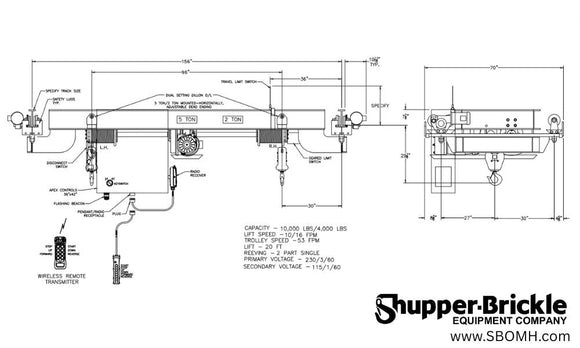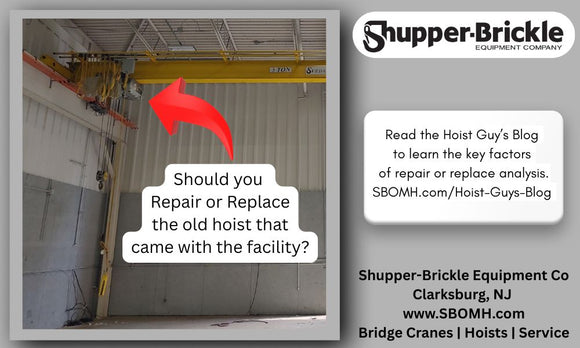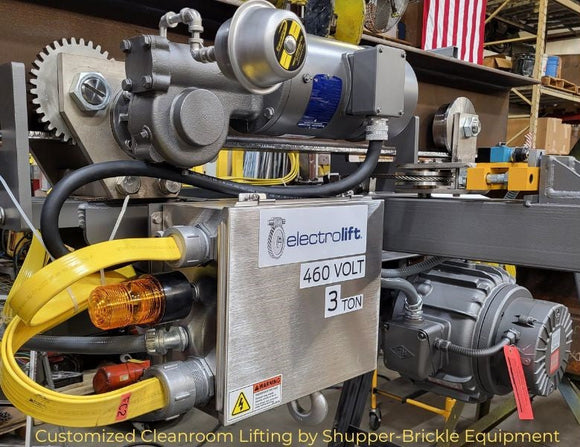
Choosing the Correct Hoist for the Job
Andrew T. Litecky
Welcome to the Hoist Guy’s Blog, where our resident hoist guy, Andrew T. Litecky offers key considerations for buying the right hoist for the job.
When purchasing a hoist, the buyer should pay special attention to these factors:
- frequency of use
- the speed of the lift
- the degree of control required
Case Study for Purchasing a Hoist
We were recently asked to recommend the best hoist for this job: A 450 lb. valve needed to be unbolted and raised off its mounting flange for routine maintenance and then reinstalled on a bolt circle with alignment studs.
On the surface, the task seems simple enough. Unbolt and rig the valve, and then lift the valve. But how do you know which hoist is the best one to buy? Our advice in this situation is to consider these key questions before deciding which hoist to purchase: How often is the operation required? (daily, monthly, annually, etc.) How fast to raise and lower the valve? How much accuracy of control is required?
Hoist Purchasing Factors: Frequency of Use & an Overload Device for Safety
If there is one valve and its maintenance cycle is once every year or so, then a manual chain hoist on a trolley may work just fine. The manual chain hoist operator would need to safely stand next to the load and pull the hand chain to lift the load. An overload slip clutch, designed to protect both equipment and operator against dangerous overloads, must be an integral part of the hoist. A chain container would be a good idea, depending on how much load chain would be used to raise the valve. For very rare usage, a simple manual system offers cost savings.
For the case of more frequent lifting or if the hoist operator could not safely stand next to the valve, or for multiple valves, an electric chain hoist, ½ ton capacity, would be the best choice. Like the manual hoist, the electric chain hoist would need to be equipped with an overload slip clutch, in case of a jam, or if someone were to forget to remove all the mounting bolts of the valve. The electric hoist with a pendant of sufficient length would allow the maintenance person to stand away from the lifting and lowering load. The simple act of putting distance between the operator and the load makes the operation safer.
Electric Hoist Purchasing Factors: Speed & Control
With the electric hoist, speed and control of the lifting and lowering are to be considered, and the least expensive control is the single speed hoist. When the up or down button is depressed, the hoist instantaneously moves at the rated top speed, with no delay. The next upgrade is a two speed hoist, and the push button pendant has two steps: Low speed and high speed. Domestic hoists typically have a 3:1 ratio high speed to low speed. This would be an operational improvement over the single speed hoist, and the two speeds are also achieved instantaneously.
The best hoist control for raising and lowering at desired speeds, and the option that affords the hoist operator the most flexibility, would be with a variable frequency drive. A VFD provides a customized option since each speed and control is programmed into the device. The top hoist speed has the VFD operating at 60 hertz. The typical high to low ratio is 10:1, so the slower speed could typically be programmed to operate at 6 hertz. For an electric chain hoist at a max speed of 16 feet per minute (FPM), the lower speed would be as low as 1.6 FPM. Accel and decel could be programmed to give the operator pinpoint control and a soft start up and landing.
Choosing the Right Trolley
Once the load is in the air, the next step is moving it along the monorail to a set down area, and for that purpose, the hoist is attached to the monorail with a trolley. For the manual hoist option, the two choices are a push trolley or a hand geared trolley. As a general rule, if the operator can push the load by hand, then the push trolley will work fine. If for some reason the operator cannot move the load by pushing on it, a hand geared trolley will allow the operator to move the load without touching it.
For an electric chain hoist, the trolley options are push, hand geared or motor driven. Again, the simplest option of pairing a manual trolley with an electric hoist is usually best whenever possible. Like the electric chain hoist, the motor driven trolley has control options which include single speed, two speed, a single or two speed with a soft start and a variable frequency drive which has a soft start and a soft stop.
Other Hoist Purchasing Considerations
Be sure to consider the application carefully when choosing the hoist and trolley. These crucial features will make a difference for job safety and operator satisfaction.
Choose the Right Hoist with Help from Shupper-Brickle Equipment
Since 1969, Shupper-Brickle Equipment has provided overhead material handling equipment and expert services. We strive to provide our customers with safe, quality overhead lifting products that are beneficial, convenient, and cost-effective. Contact us for more information or to ask us anything about hoists and overhead cranes.


